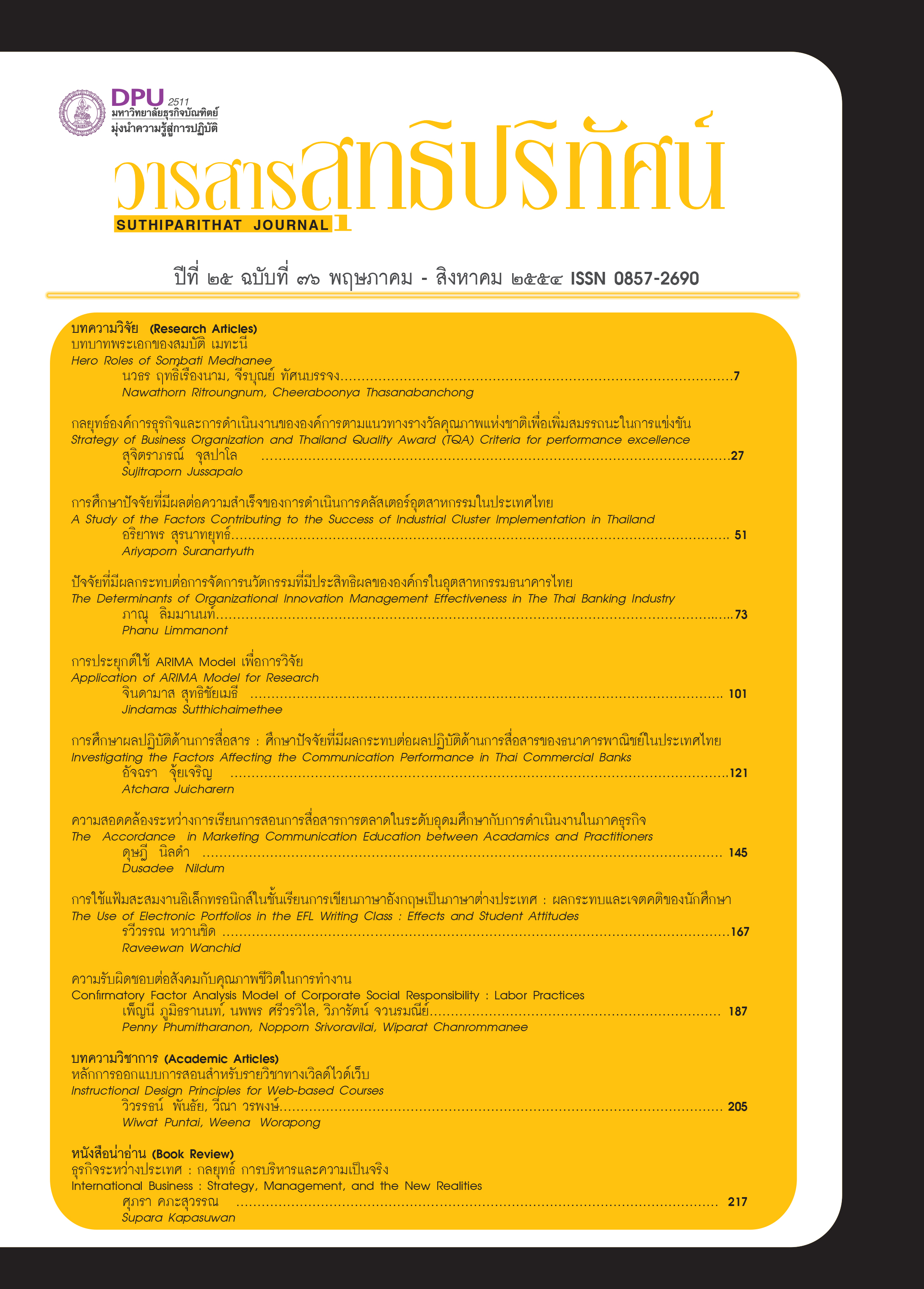การศึกษาผลปฏิบัติด้านการสื่อสาร : ศึกษาปัจจัยที่มีผลกระทบต่อผลปฏิบัติด้านการสื่อสารของธนาคารพาณิชย์ในประเทศไทย
คำสำคัญ:
การสื่อสาร, การสื่อสารอย่างมีประสิทธิผล, การสื่อสารในองค์กร, ความชัดเจนของเป้าหมาย, วัฒนธรรมขององค์กร, การกระจายอำนาจในการตัดสินใจ, และความสามารถในการสื่อสารข้ามวัฒนธรรมบทคัดย่อ
ถึงแม้การสื่อสารเป็นปัจจัยสำคัญประการหนึ่งของประสิทธิผลขององค์กรการศึกษา ปัจจัยต่อผลการปฏิบัติด้านการสื่อสารในองค์กรยังมีไม่เพียงพอ การวิจัยนี้มุ่งค้นคว้าหาความสัมพันธ์ระหว่างความชัดเจนของเป้าหมาย วัฒนธรรมขององค์กร การกระจายอำนาจใน การตัดสินใจ และความสามารถในการสื่อสารข้ามวัฒนธรรมกับผลการปฏิบัติด้านการสื่อสารในบริบทของธนาคารพาณิชย์ในประเทศไทย โดยการเก็บรวบรวมข้อมูลจากแบบสอบถามจากสาขาของธนาคารพาณิชย์ 7 ธนาคาร เนื่องจากตัวแบบการศึกษาผลปฏิบัติด้านการสื่อสารยังเป็นเชิงสำรวจอยู่ ในงานวิจัยที่ผ่านมาความสัมพันธ์ของตัวแปลบางตัวจึงยังไม่เด่นชัด ดังนั้นการศึกษานี้จึงใช้วิธีการวิเคราะห์หาความสัมพันธ์แบบสัมประสิทธิ์สหสัมพันธ์
ข้อค้นพบสำคัญของงานวิจัยประกอบด้วย (ก) เมื่อวิเคราะห์ผลการปฏิบัติด้านการสื่อสาร โดยรวมพบว่ามีความสัมพันธ์เชิงบวกของตัวแปรต้นทุกตัวกับผลการปฏิบัติด้านการสื่อสาร โดยที่ความชัดเจนของเป้าหมายมีความสัมพันธ์มากที่สุด ตามด้วยวัฒนธรรมองค์กรและการกระจายอำนาจ ตัวแปรที่มีความสัมพันธ์น้อยที่สุดคือความสามารถในการสื่อสารข้ามวัฒนธรรม
(ข) เมื่อวิเคราะห์ผลการปฏิบัติด้านการสื่อสารโดยแยกออกเป็นมิติต่างๆ คือ การสื่อสารระหว่างบุคคล การสื่อสารภายนอกองค์กร การสื่อสารภายในองค์กร พบว่ามีความสัมพันธ์เชิงบวกของตัวแปรต้นทุกตัวกับผลการปฏิบัติด้านการสื่อสาร ที่เป็นมิติการสื่อสารภายนอกองค์กรและการสื่อสารภายในองค์กร แต่ไม่พบความสัมพันธ์กับการสื่อสารระหว่างบุคคล
เอกสารอ้างอิง
Arasaratnam, L. A. 2009. The Development of a New Instrument of Intercultural Communication. Journal of Intercultural Communication. Retrieved 20 May, 2009. from http/www.immi.se/intercultural/.
Bank of Thailand. 2008. Financial Data of Commercial Banks. Retrieved April 18, 2008 from http://www.bot.or.th/English/Statistics/ FinancialInstitutions/CommercialBank/Pages/StatNumberofBranches.aspx
Berger, C. R and Calabrese, J. J. 1975. Some Explorations in Initial Interaction and Beyond: Toward a developmental theory of Interpersonal Communication. Human Communication Research. 1 (1): 99-112.
Burns, T and Stalkers, G. M. 1961. The Management of Innovation. London: Tavistock.
Byrne, Z. S and LeMay, E. 2006. Different media for organizational communication : perceptions of quality and satisfaction. Journal of Business and Psychology. 2 (2): 149-173.
Cheney, G and Christensen, T. 2000. Linkages between internal and external communication. In the New Handbook of Organizational Communication: Advance in Theory, Research, and Methods. edited by Jablin, F.M. and Putnam, L.L.Thousand Oaks. CA:Sage.
Chintana Monthienvichienchai, Chintawee Kasemsuk, Sirintorn Bhibulbhanuwat, and Speece,M. 2002. Cultural Awareness, Communication Apprehension, and Communication Competence: a Case Study of Saint John’s International School. The International Journal of Education Management. 16 (6): 288-296.
Chun, Y.H. and Rainey, H. G. 2006. Consequences of Goal Ambiguity in Public Organizations. in Public Service Performance. edited by G. Boyne, G., Meier, K., L.O’Toole Jr., and Walker, R.New York: Cambridge University Press. Pp. 92–112.
Conrad, C and Poole, M. S. 2002. Strategic Organizational Communication in a Global Economy. Orlando: Harcourt College.
Deal, T. E and Kennedy, A. A. 1982. Corporate Cultures: The Rites and Rituals of Corporate Life. Reading, MA: Addison-Wesley Publishing Co.
Drucker, P. 1974. Management: Tasks, Responsibilities, Practices. New York: Harper and Row
Fantini. A. E. 2006. Exploring and Assessing Intercultural Competence. Retrieved May 10, 2007 from http;//www.sit.edu/publications/docs /feil_research_report.pdf
Frey, L. R; Botan, C. H and Kreps, G. L. 2000. Investigating Communication an Introduction to Research Methods. Needham Heights: Allyn & Bacon.
Garnett, J. L. 1992. Communication for Results in Government: A Strategic Approach for Public Management. San Francisco: Jossey-Bass.
Garnett. 1997. Aministrative Communication: Domain, Threats, and Legitimacy. In The Handbook of Administrative Communication. James L. Garnett and Alexander Kouzmin, eds. New York: Marcel Dekker. Pp. 3-20.
Gianakis, G and Xiao, H.W. 2000. Decentralization of the Purchasing in Municipal Government: A National Survey. Journal of Public Budgeting, Accounting and Financial Management. 12(3): 421-40.
Gold, K. A.1982. Managing for Success: A Comparison of the Public and Private Sectors. Public Administration Review. 42 (6): 568-75.
Hilgermann, R.H. 1998. Communication Satisfaction, Goal Setting, Job Satisfaction, Conceptive Control, and Effectiveness in Self-managing Teams. Dissertation Abstracts International. 59 (5-A): 1661.
Katz, D and Kahn R.L. 1966. The Social Psychology of Organization. New York: Wiley.
Kotter, J. P. 1999. What Leaders Really Do. Boston: Harvard Business School Press.
Maini, B.S and Morrel-Samuels, P. 2006. Cascading improvements in communication: adopting a new approach to organizational communication, Physician Executive. 32 (5): 38-43.
McCullough, J; Heng, L. S and Khem, G. S. 1986. Measuring the Marketing Orientation of Retail Operations of International Banks. Journal of International Bank Marketing. 4 (3): 9-18.
Miller, K. I. 1999. Organizational Communication. Belmont: Wadsworth. Mintberz, H., Raisinghani, d. and Theoret, A. 1976. The Structure of ‘Unstructured’ Decision Processes. Administrative Science Quarterly. 21 (2): 246-275
Ouchi, W. 1981. Theory Z: How American Business Can Meet The Japanese Challenge. Reading. MA: Addison-Wesley.
Pandey, S. K and Garnett, J. L. 2006. Exploring Public Sector Communication Performance: Testing a Model and Drawing Implications. Organization Performance. Public Administration Review 66 (1): 37-51.
Quinn, R.E. and Kimberly, J.R. 1984. Paradox, Planning, and Perseverance: Guidelines for Managerial Practice. In Managing Organizational Translations, Kimberly, J.R. and Quinn, R.E. ed. Homewood, IL: Down Jones/Irwin. Pp. 295-313.
Rainey, H .J. 1983. Public Agencies and Private Firms: Incentives Structures, Goals, and Individual Roles. Administration & Society.
Raney, H. L. 2003 Understanding and Managing Public Organizations. San Francisco: Jossey-Bass.
Richardson, H. A; Vandenberg, R. J; Bulm, T. C and Roman, P.M. 2002. Does Decentralization Make a Difference for the Organization? An Examination of the Boundary Conditions Circumbscribing Decentralized Decision-
Making and Organizational Financial Performance. Journal of Management. 28 (2): 217-244.
Rodsutti, M. C and Swierczek, F. W. 2002. Leadership and Organizational Effectiveness in Multinational Enterprises in Southeast Asia. Leadership & Organization Development Journal. 23 (5): 250-259.
Schein, E.H.1992. Organizational Culture and Leadership. San Francisco: Jossey-Bass.
Shannon, C. E and Weaver, W. 1949. The Mathematical Theory of Communication. Urbana, IL: University of Illinois Press.
Vos, M. 2009. Communication Quality and Added Value: a Measurement Instrument for Municipalities. Journal of Communication Management. 13 (4): 362 – 377.
Woodward, J. 1965. Industrial Organization: Theory and Practice. London: Oxford University
Zammuto, R.F., and Krakower, J.Y. 1991. Quantitative and Qualitative Studies of Organizational Culture. In Woodman, R.W. and Passmore, W.A. eds. Research in Organizational Change and Development. Greenwich, CT: JAI. Pp. 83-114.
ดาวน์โหลด
เผยแพร่แล้ว
รูปแบบการอ้างอิง
ฉบับ
ประเภทบทความ
สัญญาอนุญาต
เนื้อหาและข้อมูลในบทความที่ลงตีพิมพ์ในวารสารสุทธิปริทัศน์ ถือเป็นข้อคิดเห็นและความรับผิดชอบของผู้เขียนบทความโดยตรงซึ่งกองบรรณาธิการวารสาร ไม่จำเป็นต้องเห็นด้วย หรือร่วมรับผิดชอบใด ๆ
บทความ ข้อมูล เนื้อหา รูปภาพ ฯลฯ ที่ได้รับการตีพิมพ์ในวารสารสุทธิปริทัศน์ ถือเป็นลิขสิทธิ์ของวารสารสุทธิปริทัศน์หากบุคคลหรือหน่วยงานใดต้องการนำทั้งหมดหรือส่วนหนึ่งส่วนใดไปเผยแพร่ต่อหรือเพื่อกระทำการใด ๆ จะต้องได้รับอนุญาตเป็นลายลักษณ์อักษรจากวารสารสุทธิปริทัศน์ก่อนเท่านั้น







